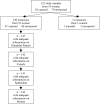Distinguishing features of endometrial pathology after exposure to the progesterone receptor modulator mifepristone
- PMID: 21315422
- PMCID: PMC3118265
- DOI: 10.1016/j.humpath.2010.11.003
Distinguishing features of endometrial pathology after exposure to the progesterone receptor modulator mifepristone
Abstract
There is growing interest in the use of progesterone receptor modulators such as mifepristone for treatment of gynecologic and other conditions, but interest in progesterone receptor modulators is dampened by the effects of the agents on the endometrium. In this study, we examined the endometria of women exposed to mifepristone for treatment of leiomyomas in doses of 2.5 and 5 mg and compared them to unexposed endometria. We assessed the reliability of these features by comparing agreement in ratings between pathologists who were blinded to each other's readings. We assessed distinguishing features between exposed and unexposed groups by comparing frequency of features between groups. We found that key features could be reliably assessed by pathologists experienced in endometrial pathology. We observed several features (nonsynchronous endometrium, large fluid filled glands, and abnormal blood vessels) that distinguished endometrial samples that were and were not exposed to the drug. These findings suggest several features that can be tracked during studies involving mifepristone and, potentially, other progesterone receptor modulators.
Copyright © 2011 Elsevier Inc. All rights reserved.
Figures




Similar articles
-
Clinical utility of progesterone receptor modulators and their effect on the endometrium.Curr Opin Obstet Gynecol. 2009 Aug;21(4):318-24. doi: 10.1097/GCO.0b013e32832e07e8. Curr Opin Obstet Gynecol. 2009. PMID: 19602929 Review.
-
Progesterone antagonists and progesterone receptor modulators.Expert Opin Investig Drugs. 2003 Oct;12(10):1693-707. doi: 10.1517/13543784.12.10.1693. Expert Opin Investig Drugs. 2003. PMID: 14519088 Review.
-
Characterization of Molecular Changes in Endometrium Associated With Chronic Use of Progesterone Receptor Modulators: Ulipristal Acetate Versus Mifepristone.Reprod Sci. 2018 Mar;25(3):320-328. doi: 10.1177/1933719117746764. Epub 2017 Dec 14. Reprod Sci. 2018. PMID: 29241443 Free PMC article.
-
Effect of mifepristone on estrogen and progesterone receptors in human endometrial and endometriotic cells in vitro.Fertil Steril. 2002 May;77(5):995-1000. doi: 10.1016/s0015-0282(02)03081-9. Fertil Steril. 2002. PMID: 12009357
-
Human endometrial epithelial telomerase is important for epithelial proliferation and glandular formation with potential implications in endometriosis.Hum Reprod. 2015 Dec;30(12):2816-28. doi: 10.1093/humrep/dev267. Epub 2015 Oct 25. Hum Reprod. 2015. PMID: 26498179
Cited by
-
Low dose mifepristone in medical management of uterine leiomyoma - an experience from a tertiary care hospital from north India.Indian J Med Res. 2013 Jun;137(6):1154-62. Indian J Med Res. 2013. PMID: 23852296 Free PMC article. Clinical Trial.
-
Safety and effectiveness of different dosage of mifepristone for the treatment of uterine fibroids: a double-blind randomized clinical trial.Int J Womens Health. 2013 Mar 19;5:115-24. doi: 10.2147/IJWH.S33125. Print 2013. Int J Womens Health. 2013. PMID: 23658500 Free PMC article.
-
Distinct clinicopathological features of ovarian endometriosis after long-term exposure to mifepristone.J Int Med Res. 2022 Nov;50(11):3000605221134471. doi: 10.1177/03000605221134471. J Int Med Res. 2022. PMID: 36348508 Free PMC article.
-
Mifepristone 2.5 mg versus 5 mg daily in the treatment of leiomyoma before surgery.Int J Womens Health. 2012;4:75-84. doi: 10.2147/IJWH.S28103. Epub 2012 Mar 13. Int J Womens Health. 2012. PMID: 22448109 Free PMC article.
-
Treatment of Uterine Myoma with 2.5 or 5 mg Mifepristone Daily during 3 Months with 9 Months Posttreatment Followup: Randomized Clinical Trial.ISRN Obstet Gynecol. 2013 Jul 29;2013:649030. doi: 10.1155/2013/649030. eCollection 2013. ISRN Obstet Gynecol. 2013. PMID: 23984082 Free PMC article.
References
-
- Eisinger SH, Meldrum S, Fiscella K, le Roux HD, Guzick DS. Low-dose mifepristone for uterine leiomyomas. Obstet Gynecol. 2003;101:243–250. - PubMed
-
- Fiscella K, Eisinger SH, Meldrum S, et al. Effect of mifepristone for symptomatic leiomyomas on quality of life and uterine size: a randomized controlled trial. Obstet Gynecol. 2006;108:1381–1387. - PubMed
-
- Bagaria M, Suneja A, Vaid NB, Guleria K, Mishra K. Low-dose mifepristone in treatment of uterine leiomyoma: a randomised double-blind placebo-controlled clinical trial. Aust NZ J Obstet Gynecol. 2009;49:77–83. - PubMed
-
- Eisinger SH, Fiscella J, Bonfiglio T, Meldrum S, Fiscella K. Open-label study of ultra low-dose mifepristone for the treatment of uterine leiomyomas. Eur J Obstet Gynecol Reprod Biol. 2009 In Press, Corrected Proof. - PubMed
-
- Carbonell Esteve JL, Acosta R, Heredia B, et al. Mifepristone for the treatment of uterine leiomyomas: a randomized controlled trial. Obstet Gynecol. 2008;112:1029–1036. - PubMed
Publication types
MeSH terms
Substances
Grants and funding
LinkOut - more resources
Full Text Sources
Research Materials

